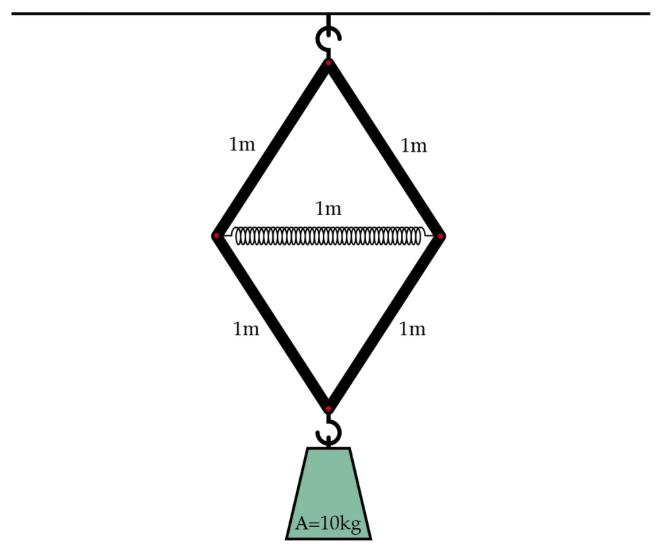A squeezing spring
 A spring and four bars are hung from the ceiling in the configuration above. Each of the bars can pivot and rotate where it meets the other bar. The spring has a natural length of 1 m and a spring constant of 1000 N/m, while each of the bars has a length of 1 m and is effectively massless. A 10 kg weight is then hooked on to the bottom of this contraption at point A, causing the spring to squeeze. When the system comes to equilibrium, what is the length of the spring in
meters
?
A spring and four bars are hung from the ceiling in the configuration above. Each of the bars can pivot and rotate where it meets the other bar. The spring has a natural length of 1 m and a spring constant of 1000 N/m, while each of the bars has a length of 1 m and is effectively massless. A 10 kg weight is then hooked on to the bottom of this contraption at point A, causing the spring to squeeze. When the system comes to equilibrium, what is the length of the spring in
meters
?
Details and assumptions
- The acceleration of gravity is .
- The spring doesn't squeeze all that much, so you may assume that the vertical angles on the top and bottom remain at degrees, where is a small angle.
The answer is 0.946.
This section requires Javascript.
You are seeing this because something didn't load right. We suggest you, (a) try
refreshing the page, (b) enabling javascript if it is disabled on your browser and,
finally, (c)
loading the
non-javascript version of this page
. We're sorry about the hassle.
The equilibrium point of the system after the weight is added will be at the minimum of potential energy. There is both gravitational and spring potential energy in the system. If t h e t a is the angle between the lower right bar and the vertical axis, then h , the change in height of the mass, is
h = 2 ( c o s π / 6 − c o s θ ) .
The compression distance d of the spring, meanwhile, is
d = 1 − 2 s i n θ .
The total potential energy of the system is the sum of the spring potential and gravitational potential,
U = 2 1 k d 2 + m g h , which evaluates to
U = 5 0 0 ( 1 − 2 s i n θ ) 2 − 2 0 × 9 . 8 ( c o s θ − c o s π / 6 ) .
Minimizing this with respect to θ gives the solution. We minimize by taking the derivative and setting it equal to zero, i.e.
0 = − 1 0 0 c o s θ ( 1 − 2 s i n θ ) + g s i n θ .
If we define θ = π / 6 + ϵ , where ϵ < < 1 , we can use trigonometric identities and the small angle approximation to solve for ϵ = − 0 . 0 3 0 9 . The length of the spring is L = 2 s i n ( π / 6 + ϵ ) = 0 . 9 4 6 m.